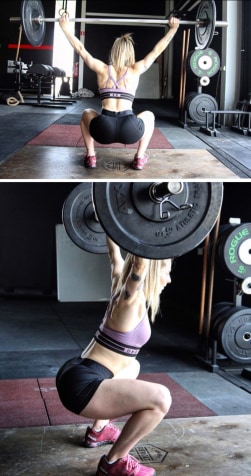The Overhead Squat is the most basic snatch receiving position strength exercise and can be used prior the snatch as a learning progression. It can also serve as a mobility exercise to improve a lifter’s bottom position for the snatch. In order to perform this lift correctly, an athlete must have high level of coordination, balance and mobility. If there is any problem or weakness in the whole chain of the movement, it becomes quickly evident when executing the Overhead Squat.
How to execute:
To start, hold the bar on your upper back, with the elbows pulled under the barbell, and keep an erect position. The bar may be either power snatched from the floor or taken from the rack.
Place your feet between hip and shoulder width, with your toes pointed slightly outward.
Keep a wide grip on the barbell.
Create a rigid trunk by taking a big breath and holding it tight.
Dip and drive to push the bar into an overhead position (behind the neck push press). Drive your hands to the ceiling and lock your elbows out. Your armpits should face forward.
In the overhead position, the barbell should rest in the center of the palm with the wrists slightly extended. The abdominal and erector spinae should be contracted to stabilize the torso.
Use a slight hip hinge and let your hips descend back and down till they reach lower than your knees.
Keep the bar over the mid foot during the squat for balance and stability.
Push your heels down, maintain your lumbar curve and keep your knees in line with your toes, to reduce any unnecessary load on the knee joint
Your hips and chest rise at the same rate on the ascent. Complete at full hip and knee extension.
✔Extra tips
If flexibility issues prevent an athlete from performing the movement through the full range of motion, a partial range can be used.
For novice athletes start with a PVC pipe or broomstick instead of a barbell.
To find the proper hand placement on the bar, stand tall and pull your elbows out to the side. Your arms should end up in 90 degree or “L” position.
When the weight on the bar is relatively light, you can use a push press (behind the neck), to bring the bar to an overhead position. For experienced athletes who use high loads, a push jerk or split jerk is recommended.
The ability to perform an overhead squat correctly is a good test of ankle, knee, hip, and shoulder mobility and midline control. Overhead squatting can help in strengthening the lower extremity and stabilizing musculature of the shoulder complex and spine. However, I would not recommend it to everyone. If you are an advanced athlete then go for it, but if you struggle to squat properly even without a barbell, then you should start prioritizing aspects such as overall mobility, strength and body control, and then move on to something more advanced such as the overhead squat!
(Horschig, 2017, Auferoth & Joseph, 1988, Chiu & Burkhardt, 2011, Everett, 2016)
